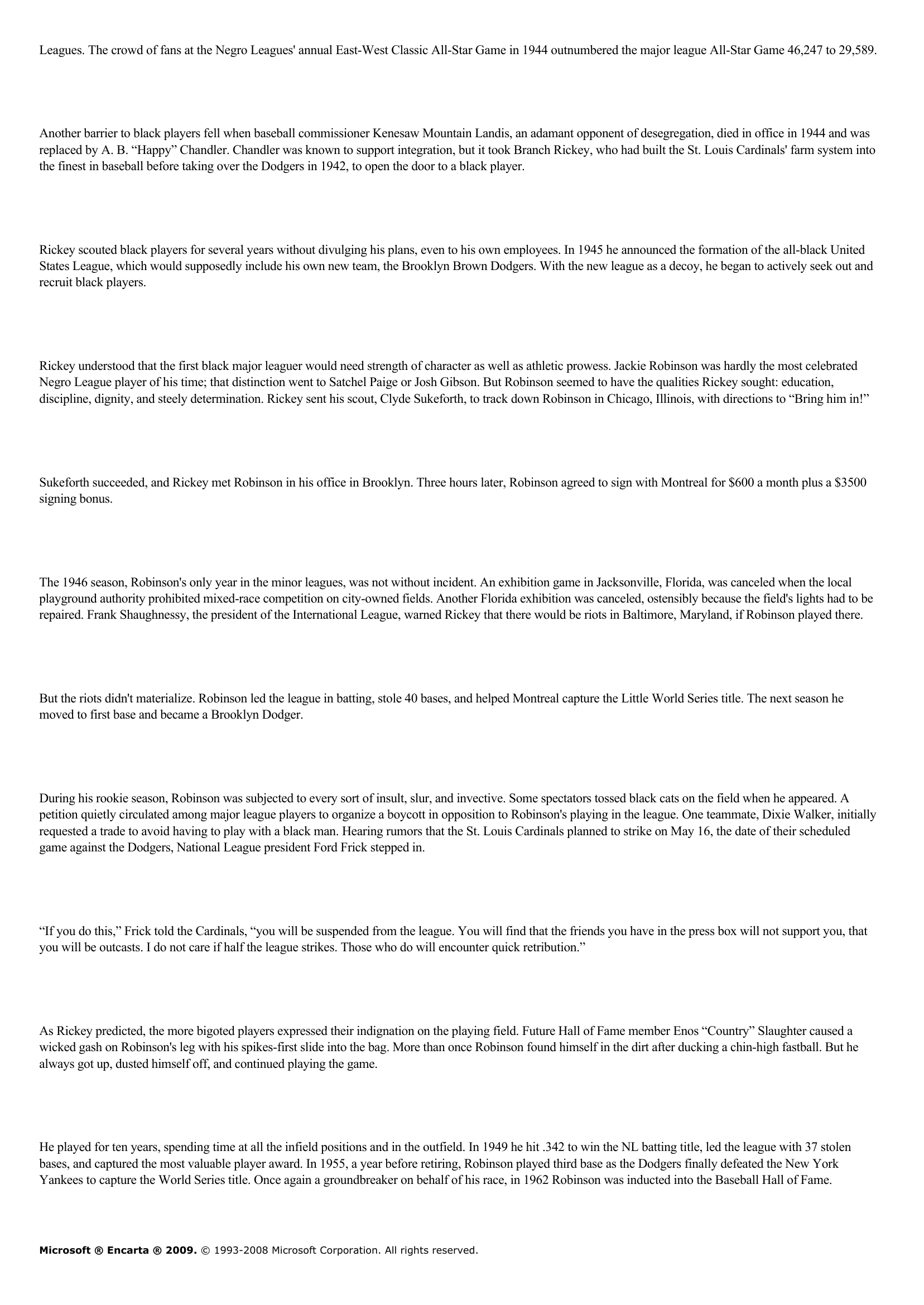Jackie Robinson Breaks the Barrier.
Publié le 14/05/2013

Extrait du document
«
Leagues.
The crowd of fans at the Negro Leagues' annual East-West Classic All-Star Game in 1944 outnumbered the major league All-Star Game 46,247 to 29,589.
Another barrier to black players fell when baseball commissioner Kenesaw Mountain Landis, an adamant opponent of desegregation, died in office in 1944 and wasreplaced by A.
B.
“Happy” Chandler.
Chandler was known to support integration, but it took Branch Rickey, who had built the St.
Louis Cardinals' farm system intothe finest in baseball before taking over the Dodgers in 1942, to open the door to a black player.
Rickey scouted black players for several years without divulging his plans, even to his own employees.
In 1945 he announced the formation of the all-black UnitedStates League, which would supposedly include his own new team, the Brooklyn Brown Dodgers.
With the new league as a decoy, he began to actively seek out andrecruit black players.
Rickey understood that the first black major leaguer would need strength of character as well as athletic prowess.
Jackie Robinson was hardly the most celebratedNegro League player of his time; that distinction went to Satchel Paige or Josh Gibson.
But Robinson seemed to have the qualities Rickey sought: education,discipline, dignity, and steely determination.
Rickey sent his scout, Clyde Sukeforth, to track down Robinson in Chicago, Illinois, with directions to “Bring him in!”
Sukeforth succeeded, and Rickey met Robinson in his office in Brooklyn.
Three hours later, Robinson agreed to sign with Montreal for $600 a month plus a $3500signing bonus.
The 1946 season, Robinson's only year in the minor leagues, was not without incident.
An exhibition game in Jacksonville, Florida, was canceled when the localplayground authority prohibited mixed-race competition on city-owned fields.
Another Florida exhibition was canceled, ostensibly because the field's lights had to berepaired.
Frank Shaughnessy, the president of the International League, warned Rickey that there would be riots in Baltimore, Maryland, if Robinson played there.
But the riots didn't materialize.
Robinson led the league in batting, stole 40 bases, and helped Montreal capture the Little World Series title.
The next season hemoved to first base and became a Brooklyn Dodger.
During his rookie season, Robinson was subjected to every sort of insult, slur, and invective.
Some spectators tossed black cats on the field when he appeared.
Apetition quietly circulated among major league players to organize a boycott in opposition to Robinson's playing in the league.
One teammate, Dixie Walker, initiallyrequested a trade to avoid having to play with a black man.
Hearing rumors that the St.
Louis Cardinals planned to strike on May 16, the date of their scheduledgame against the Dodgers, National League president Ford Frick stepped in.
“If you do this,” Frick told the Cardinals, “you will be suspended from the league.
You will find that the friends you have in the press box will not support you, thatyou will be outcasts.
I do not care if half the league strikes.
Those who do will encounter quick retribution.”
As Rickey predicted, the more bigoted players expressed their indignation on the playing field.
Future Hall of Fame member Enos “Country” Slaughter caused awicked gash on Robinson's leg with his spikes-first slide into the bag.
More than once Robinson found himself in the dirt after ducking a chin-high fastball.
But healways got up, dusted himself off, and continued playing the game.
He played for ten years, spending time at all the infield positions and in the outfield.
In 1949 he hit .342 to win the NL batting title, led the league with 37 stolenbases, and captured the most valuable player award.
In 1955, a year before retiring, Robinson played third base as the Dodgers finally defeated the New YorkYankees to capture the World Series title.
Once again a groundbreaker on behalf of his race, in 1962 Robinson was inducted into the Baseball Hall of Fame.
Microsoft ® Encarta ® 2009. © 1993-2008 Microsoft Corporation.
All rights reserved..
»
↓↓↓ APERÇU DU DOCUMENT ↓↓↓
Liens utiles
- is the cultural difference a barrier between individuals.
- Robinson Crusoe (extrait) Daniel Defoe (...) In a little time I began to speak to him, and teach him to speak to me; and, first, I made him know his name should be Friday, which was the day I saved his life.
- Jackie Joyner-Kersee Jackie Joyner-Kersee, born in 1962, American track-and-field athlete, who won the heptathlon event (an all-around event) at the Olympic Games in 1988 and 1992.
- Jackie Robinson.
- Jackie Robinson - USA History.

































